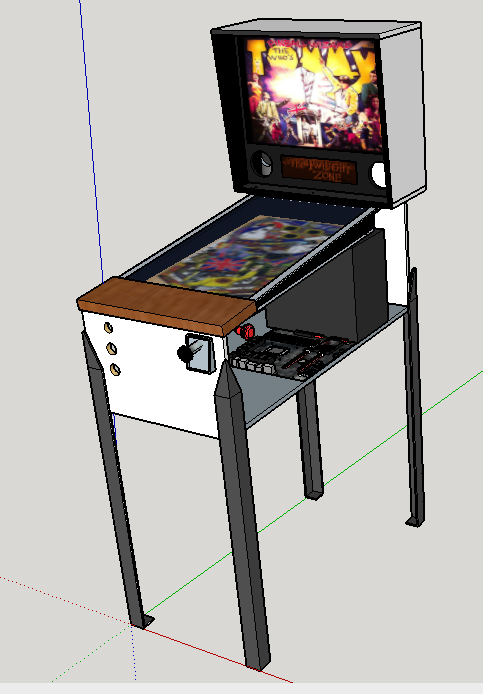I spent countless hours in December 2014 making a CAD model of the cabinet in Sketchup.
In the Github repo you can find different versions of the Sketchup model:

I realized that I had to buy the major components so that I could adapt the size of the cabinet to the major parts (monitors, subwoofer and speakers, mainly).
Speakers
The VIsual Pinball and VPinMAME software is supposed to be able to separate the pinball table's music etc from the simulated sounds of the flippers and bumpers into separate speaker channels.
Therefore I got a 5.1 speaker system, with the intent of placing two satellite speakers in the front part of the cabinet to play the sound effects, two satellite speakers in the backbox, and a subwoofer in the middle of the cabinet.
Monitors
I 'decased' my monitors, taking the plastic frame and back off to make the cabinet as slim as possible.
Originally I had planned on using two monitors, but after learning that my motherboard could drive three monitors simultaneously, I decided to get a third small (15") monitor for the dot matrix display (DMD, which shows the scores among other things). I'll rotate it 90° and place it in the base cabinet behind the subwoofer (inspired by zany's build, see their video here which is much more fancy than my mounting).
CAD
I measured the monitors, speakers etc and made models ('components' in Sketchup terminology) for them.
The height of the cabinet was determined by the subwoofer, which is placed directly below the playfield screen.
I tried to get the proportions as similar as possible to a real pinball cabinet. The cabinet tilts about 3° due to the legs being higher in the rear (they are mounter further down on the cabinet) than in the front, the angle of the playfield relative to the cabinet is about another three degrees, and the top part of the cabinet is another three degrees, summing to about 9° from the horizontal.
The whole cabinet is about 40 cm wide by 80 cm deep.
I changed my mind about what thickness of plywood to use a couple of times, and Sketchup required lots of manual fiddling to adjust all the dimensions.
Ventilation

Many pinball cabinet builds seem to have large fans at the back of the cabinet. I will try to manage with out them.
My plan for the ventilation is to make holes at the bottom front of the cabinet, where cool air can enter. The air will be heated by the monitor and motherboard, and be drawn through the power supply, which is placed right in front of the subwoofer. I'll try to block of the center of the cabinet around the subwoofer and cabinet, so the air is forced through back through the PSU. Then it will rise behind the backbox screens, and exit and the top back of the cabinet, like a chimney. I'll make some holes for letting cool air in at the rear bottom of the cabinet too.
Discussions
Become a Hackaday.io Member
Create an account to leave a comment. Already have an account? Log In.